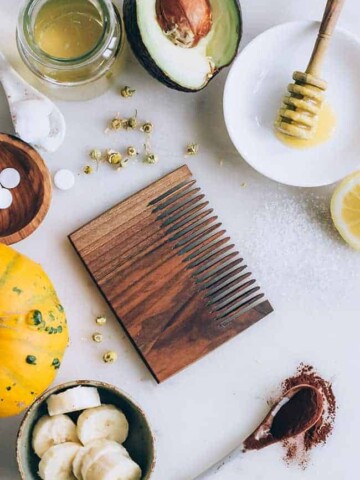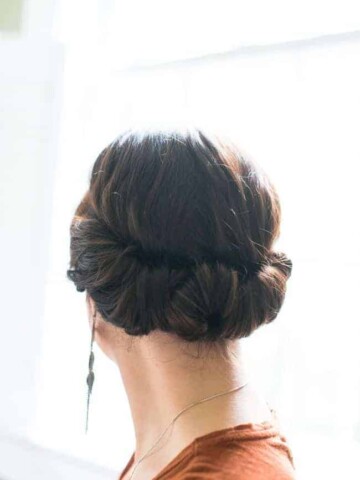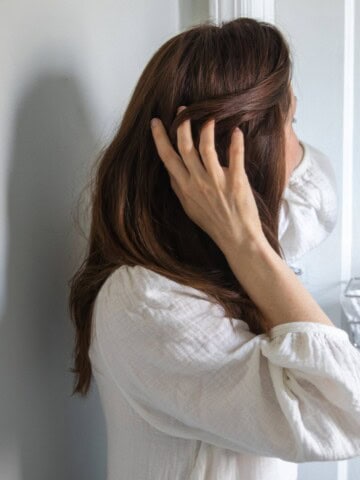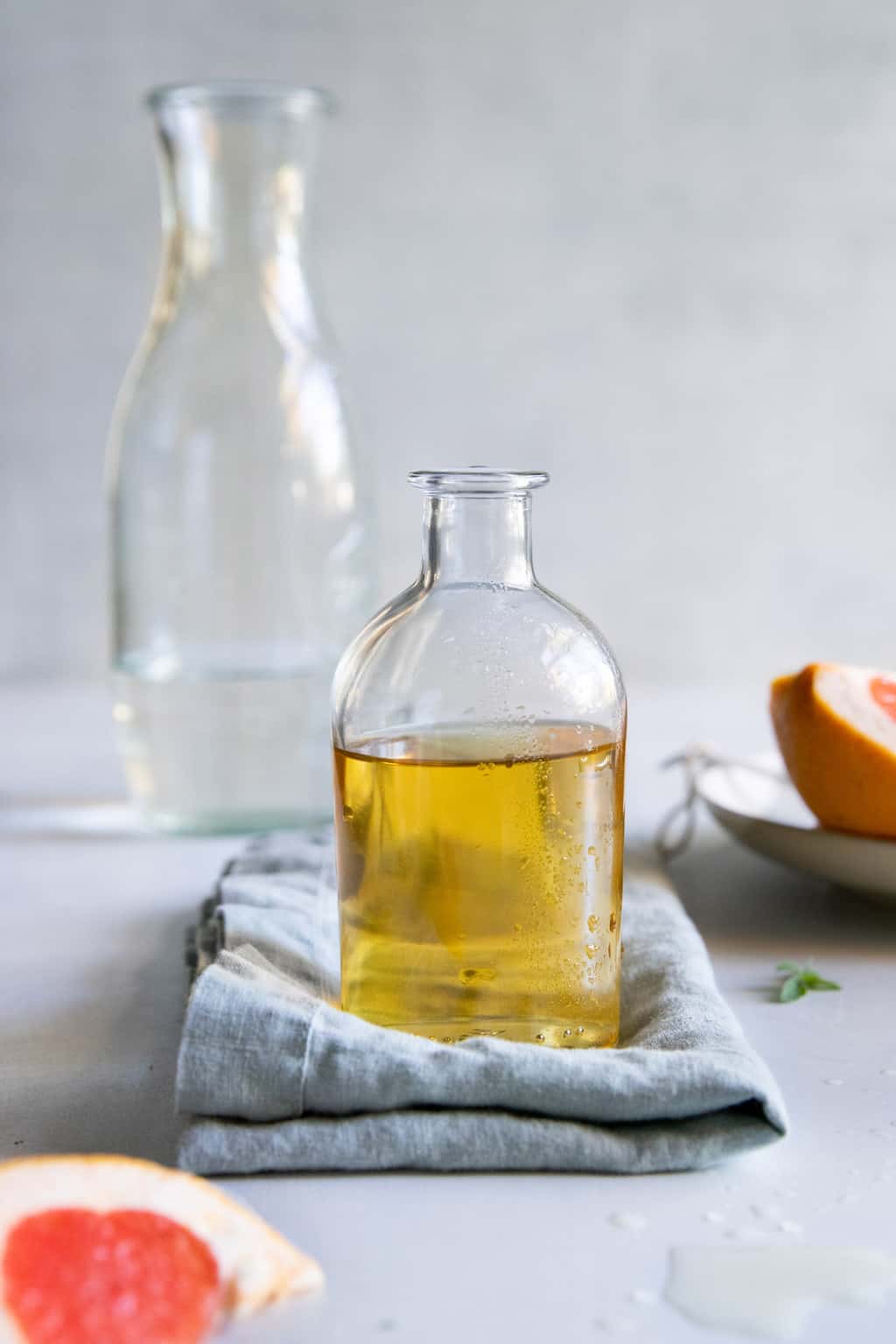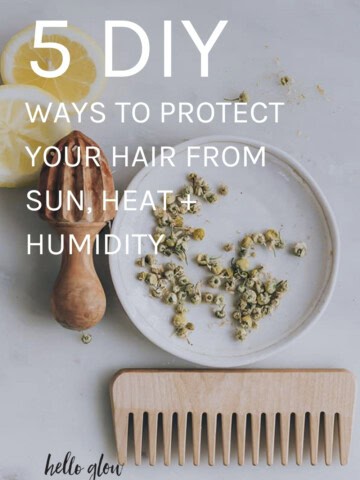Have you ever been tempted to forgo shampoo? I'll be honest: the no-shampoo adjustment period, which is said to last weeks, has me totally petrified. Who can endure a 2-week-long bad hair day? If you're also not ready for "no poo," as some call it, there's good news: a deep-cleansing DIY scalp scrub will not only leave your hair refreshed, but it will also feel amazing. Here are three recipes to try.
Meet the Experts
Penny James, IAT-certified trichologist and owner of Penny James Salon
Kerry Yates, a trichologist, hair stylist, and the founder of Colour Collective
Bridgette Hill, certified trichologist
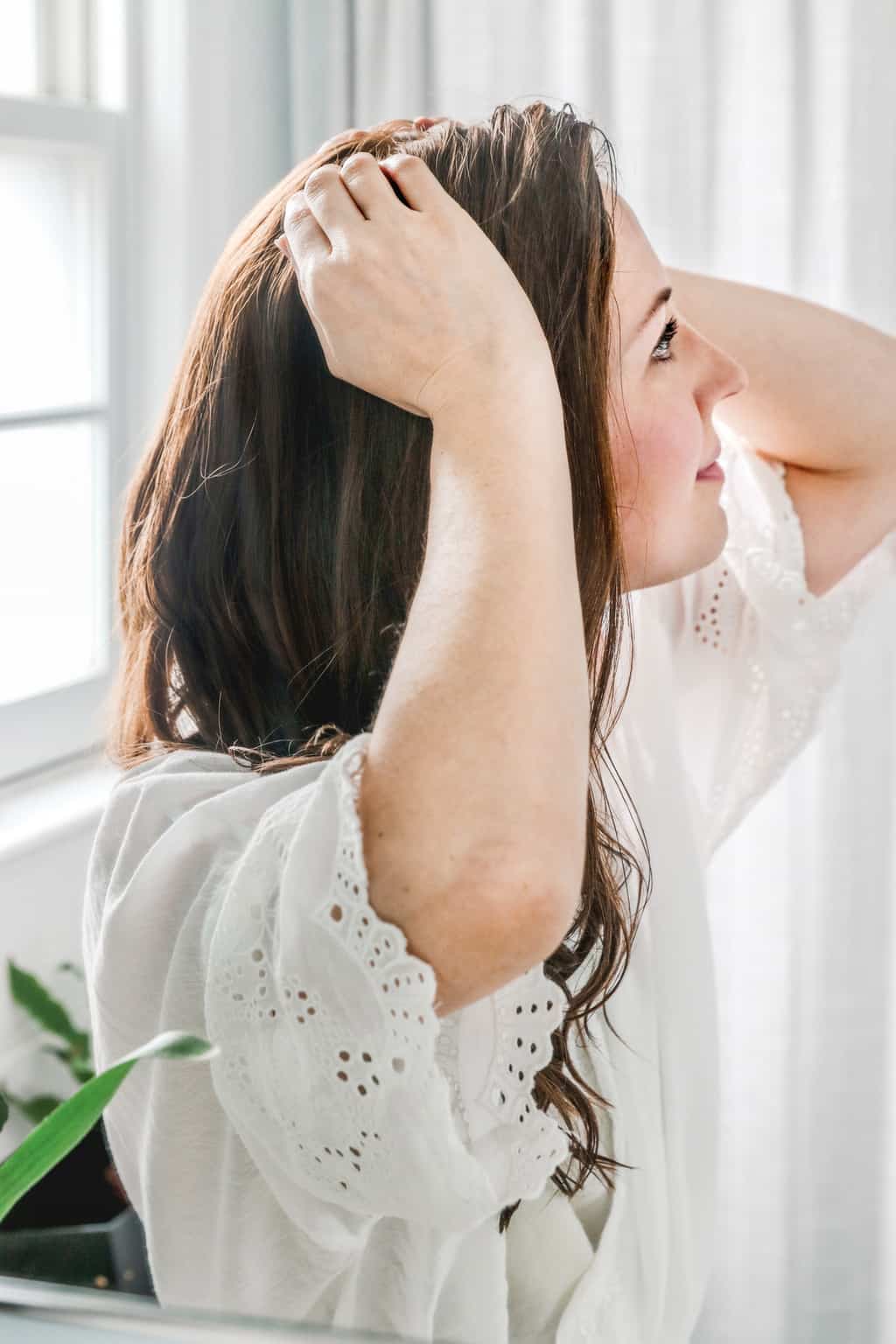
What is a scalp scrub?
For those who don't know, a scalp scrub is somewhat like a body scrub. It's full of exfoliating ingredients and is intended to cleanse the scalp by removing dead skin and environmental buildup, explains stylist Penny James, IAT-certified trichologist and owner of Penny James Salon in New York City. "After a scalp scrub, your hair not only feels healthier, but it will look fuller too," she says. "It’s especially ideal for those who use a lot of dry shampoo, as a scalp scrub is the best way to remove the cosmetic buildup on the epidermis and keep the hair follicles clean."
Who needs a scalp scrub?
The regular use of conditioners, gels, and hair spray can also make hair dull and flat. So it is vital to strip away this buildup on your scalp and follicles without jeopardizing the health of your hair. If your hair looks limp and lifeless, and maybe you're noticing a little more grease than usual, it's time to give your scalp some TLC with a deep cleansing scrub.
One of the best things about scalp scrubs is that they can be used for all hair types—and they're especially beneficial for anyone who experiences a challenge with dandruff, notes Kerry Yates, a trichologist, hair stylist, and the founder of Colour Collective. However, she does emphasize that curly hair types will need to give their hair an additional 5 minutes of rinsing time to ensure all scrub elements are washed away. "Failure to thoroughly rinse can again lead to product buildup and would defeat the purpose of using a scalp scrub," she adds.
3 Easy & Inexpensive DIY Scalp Scrubs
A healthy scalp also means healthy hair in the long run—so it’s worth tackling the issue to benefit both your scalp and your hair. Here are three of the most common scalp-related issues, what they're telling you, and how you can fix 'em.
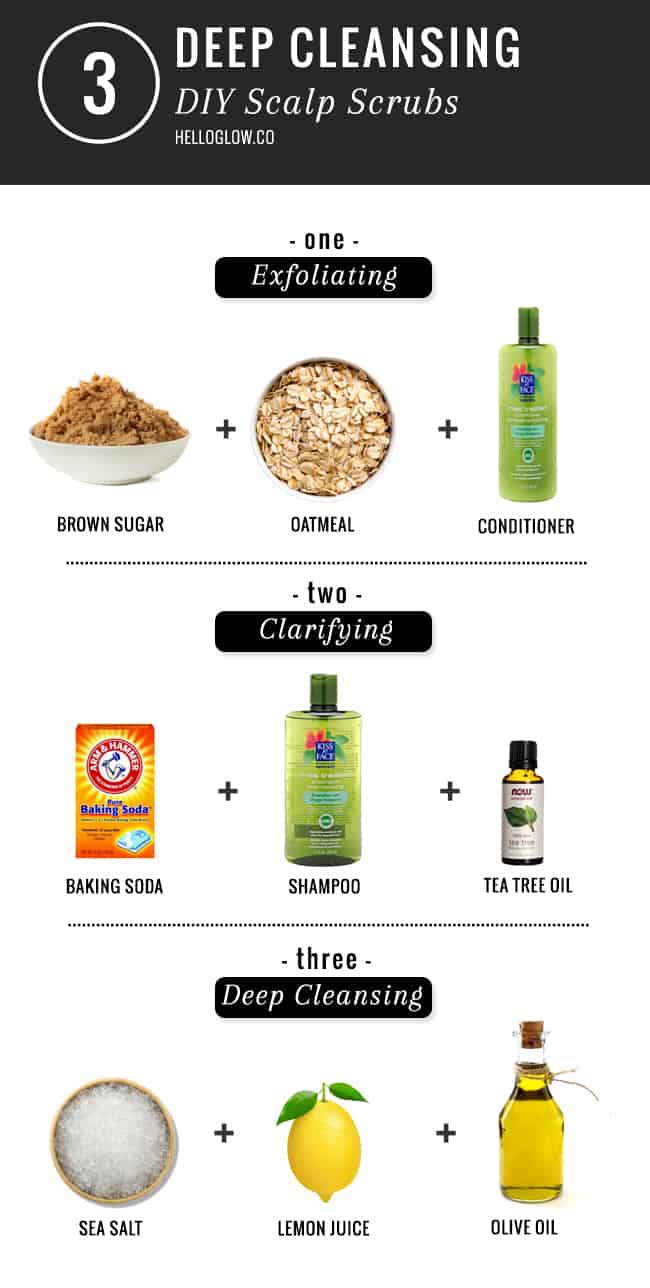
Is your scalp oily?
If you have an oily scalp, you know how frustrating it can be for your hair to feel squeaky clean one minute and dirty the next. Hair gets oily because the sebaceous glands in your scalp follicles produce excess sebum, which holds onto dirt and weighs hair down, making it look dirty all too soon.
Shampooing too much or too little can throw off the balance of your scalp’s healthy oil production.
Several factors can send those follicles into overdrive, but the first thing to try is simple: shampoo less often.
It may sound counter-intuitive, but cleansing actually strips your hair of oil, causing your scalp to respond by producing more! So by shampooing less, you can train your hair over time and teach those little factories to produce less oil.
1. Exfoliating Brown Sugar + Oatmeal Scrub
"For highly irritated, tender, scaly scalps, oatmeal-based exfoliants can assist with turning over the skin cells while offering reparative properties to the tissues of the scalp," says Hill. This specialized scrub combines brown sugar and oatmeal to gently exfoliate, provide moisture, and increase circulation to the hair follicles. These ingredients exfoliate in a balanced way without adding excess oil or drying out your scalp.
—2 tablespoons brown sugar
—1 tablespoon finely ground oatmeal
—2 tablespoons hair conditioner
Combine all of the ingredients in a bowl. Shampoo your hair first to remove any styling products. Then scoop a small amount of this scrub into the palm of your hand. Work it into your scalp using a circular motion. Rinse your hair thoroughly and shampoo, if desired.
Is your scalp dry?
Dryness is caused by too little moisture in the skin, which then causes your scalp to become irritated and the skin to flake off. While there are many factors at play when it comes to dry scalp, it usually happens for pretty simple reasons. Two of the most common? Cold, dry air, and harsh styling products.
Up your hydration, and give your scalp and strands a little break from styling whenever you can. And just like with an oily scalp, it’s important not to wash your hair too often, or you risk stripping away its natural oils.
2. Deep Cleansing Salt + Olive Oil Scalp Scrub
Salt and oil combine to stimulate hair growth and remove any flaky stuff without drying out the scalp. Olive oil makes an excellent conditioning mask as its fatty acids coat the hair, providing moisture and protection against damage. Salt exfoliates the scalp, while the lemon juice dissolves any product residue.
If you don't have lemon juice on hand, you can substitute apple cider vinegar, which helps close the cuticle and retain moisture—thanks to its acidic nature, notes Hill. Apple cider vinegar is also excellent for restoring shine, making it a very good DIY scrub ingredient.
—2 tablespoons sea salt
—1–2 tablespoons lemon juice
—1–2 tablespoons olive oil
Mix salt, lemon juice, and oil together. Then wet your hair and massage the scrub into your scalp. Let it sit for several minutes. Rinse it well and follow with your usual shampoo.
Is your scalp flaky?
When we think of flakes, most often we’re imagining that unsightly dandruff. Unlike with a dry scalp, dandruff flakes are caused by too much oil. This excess oil encourages the overgrowth of a natural yeast on the scalp, causing skin cells to build up and your body to respond with uncomfortable redness and itching [source].
Before turning to a harsh, medicated shampoo, treat your scalp. Start by getting rid of styling product buildup (which could be a cause of your flakes). Then follow up by getting your scalp’s oil levels back to normal (if your scalp is super oily).
3. Clarifying Shampoo + Baking Soda DIY Scalp Scrub
Baking soda-based DIY exfoliators and scrubs are ideal for nonproblematic symptom-free scalps, according to trichologist Bridgette Hill. She also recommends baking soda for removing product buildup, as it provides antifungal properties. "It is very common for undetected fungal colonies to form in tightly coiled dense, thick hair that is braided down or covered," she says.
Add baking soda to your shampoo for an easy and inexpensive clarifying shampoo that gently absorbs oil and removes product buildup. Use 1–2 times a month to maintain your scalp's natural pH level.
Tea tree essential oil is naturally antifungal and antibacterial [source], so using it on your hair helps eliminate the sources of flakes and dandruff, too. To dislodge existing flakes, you can add a tablespoon or two of salt to your scrub.
Note before using: This scrub isn't recommended for color-treated hair as the baking soda can strip out hair color.
—1 heaping tablespoon baking soda
—Big squeeze of shampoo (roughly 1 tablespoon)
—A few drops of tea tree essential oil
Combine all of the ingredients and distribute the mixture well through your hair, focusing on the scalp and roots. Work the scrub into your hair, and enjoy a nice scalp massage to remove the accumulated product and dead skin buildup. Rinse thoroughly with warm water and, if needed, shampoo hair a second time to get rid of any lingering baking soda.
Finish your scalp treatment with a moisturizing coconut oil, honey, or avocado hair mask or an apple cider vinegar rinse. This can help seal the cuticle, the hair’s outermost layer, leaving it smooth and super shiny.
Want to spark new hair growth? Try a scalp massage.
Helpful Tips
- Use gentle, circular motions. When massaging the scrub into your scalp, use your fingertips (not your nails) to gently rub in circular motions. This improves circulation and ensures a thorough exfoliation without scratching or damaging your scalp.
- Focus on the scalp, not the hair. The purpose of the scrub is to exfoliate the scalp, so concentrate on massaging the roots. Don’t rub the scrub into your hair strands, as they don’t need exfoliation.
- Don’t overdo it. Over-exfoliating can cause irritation and strip away natural oils, leading to dryness. Stick to using a scalp scrub once a week or every other week, depending on your scalp’s needs.
- Follow with a shampoo. Always shampoo after using a scalp scrub to clean away any leftover scrub and oils. This also helps prevent clogged follicles and ensures your scalp is left feeling fresh.
- Condition your hair after. Using a scalp scrub can leave your hair feeling a bit dry, so follow up with a conditioner or a scalp treatment to rehydrate and nourish your hair.
- Test for sensitivity. If you're using a new scrub, test it on a small patch of your scalp first to ensure you don’t have a reaction, especially if it contains essential oils or strong exfoliants.
Scalp Scrub FAQs
The best scalp scrubs typically include a mix of natural exfoliants, nourishing oils, and soothing elements. For exfoliation, sugar or sea salt are ideal choices because they gently scrub away buildup without being too harsh. To add moisture and nourishment, oils like coconut oil or jojoba oil work well. And for soothing benefits, you can incorporate things like aloe vera or essential oils.
Yes, when done correctly, scalp scrubs can help create a healthier environment for hair follicles, promoting better hair growth and overall scalp health. They work by exfoliating the scalp, removing dead skin cells, excess oil, product buildup, and dandruff, which in turn allows hair to grow stronger and more resilient.
Whether you should choose sugar- or salt-based scrubs really depends on your scalp health. Sugar dissolves easily in water, making it great for sensitive scalps. Meanwhile, sea salt is more effective for oily or dandruff-prone scalps due to its detoxifying properties.
Always exfoliate your scalp when it’s wet or damp. Wetting the scalp softens the skin and hair, making it easier to apply and massage the scrub without causing irritation. This also allows the scrub ingredients (like sugar or sea salt) to dissolve or glide more easily, allowing for a gentler and more effective exfoliation.
While it's a matter of personal preference, I recommend always shampooing after a scalp scrub. Washing your hair and scalp helps get rid of any leftover ingredients and oils that may make hair feel grimy or limp.
For most people, using a scalp scrub once a week or every other week is ideal for maintaining a clean, balanced scalp without causing issues. As long as it’s done in moderation and with gentle, nourishing ingredients, weekly scalp scrubs can significantly improve the health of your hair.
No, I recommend doing these scalp scrubs one at a time with several days rest time in between. While you can mix and match ingredients from the different scrubs, you'll never know which scrub works best for your particular hair type if you do them all at once or combine all the ingredients into one scrub.
3 DIY Scalp Scrubs
Equipment
- Small bowl
Materials
Exfoliating Brown Sugar Scrub for Oily Scalp
- 2 tablespoons brown sugar
- 1 tablespoon finely ground oatmeal
- 2 tablespoons hair conditioner
Salt and Olive Oil Scrub for Dry Scalp
Shampoo and Baking Soda Scrub for Flaky Scalp
- 1 heaping tablespoon baking soda
- Large squeeze of shampoo —roughly 1 tablespoon
- 3–4 drops tea tree oil
Instructions
Exfoliating Brown Sugar Scrub for Oily Scalp
- Combine all of the ingredients in a bowl. Shampoo your hair first to remove any styling products, and then scoop a small amount in the palm of your hand. Apply and work the scrub into your scalp, using a circular motion. Rinse hair thoroughly.
Salt and Olive Oil Scrub for Dry Scalp
- Mix salt, lemon juice, and oil together . Then wet your hair and massage the scrub into your scalp. Let it sit for several minutes. Then rinse well and follow with shampoo.
Shampoo and Baking Soda Scrub for Flaky Scalp
- Combine all of the ingredients and apply the mixture throughout your hair, focusing on the scalp and roots. Give yourself a couple of minutes to work the scrub into your hair, and enjoy a nice scalp massage to remove the accumulated product and dead skin buildup. Rinse thoroughly with warm water. Note: this scrub isn't recommended for color-treated hair as the baking soda can strip out hair color.
Notes
This post was medically reviewed by Dr. Jennifer Haley, a board-certified dermatologist with extensive experience in medical, cosmetic, and surgical dermatology. Learn more about Hello Glow’s medical reviewers here. As always, this is not personal medical advice, and we recommend that you talk with your doctor.



